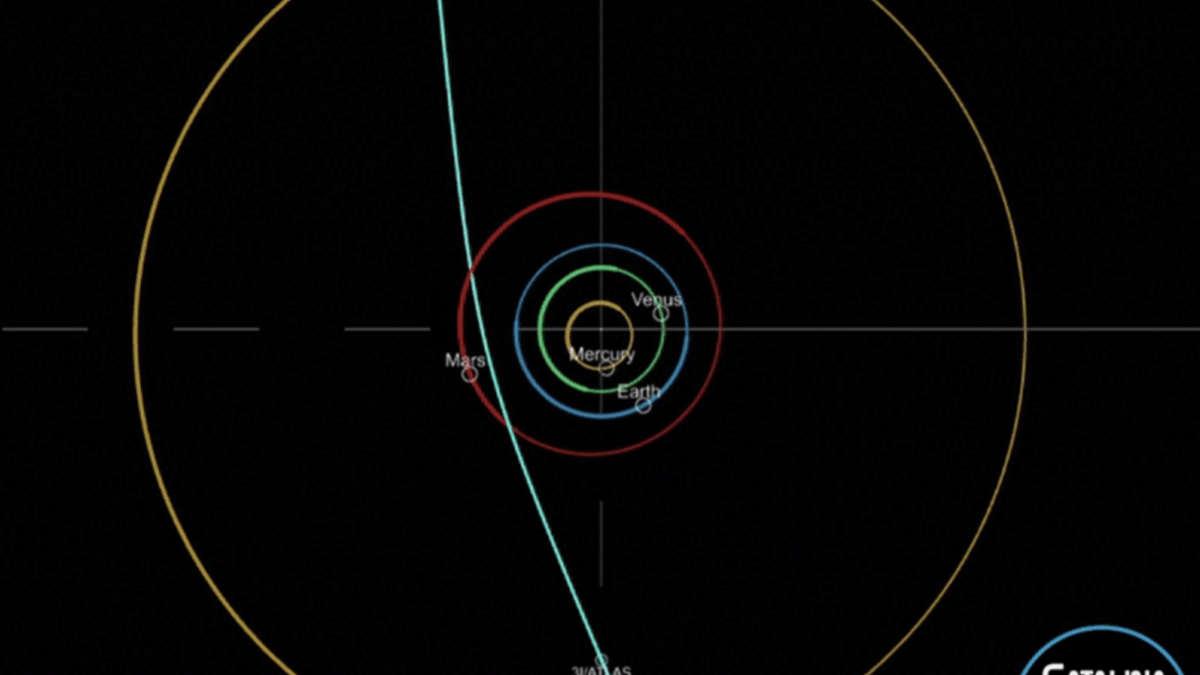A snapshot of the orbit of 3I/ATLAS (light blue) through the solar system. The concentric rings at the centre depict the orbits of the solar system’s inner planets. The orange ring is Jupiter’s orbit.
| Photo Credit: CSS, D. Rankin (CC BY-SA)
On July 1, scientists using the ATLAS survey telescope in Chile reported they had discovered an object in space they called 3I/ATLAS, after tracking it since June 14 this year. They quickly recognised the object was interstellar: its highly elliptical orbit around the sun and how quickly it was moving through space, at about 57-68 km/s relative to the sun, were clear giveaways. In fact, its path was found to trace back to the direction of the constellation Sagittarius.
NASA has already said 3I/ATLAS won’t pose any threat to the earth. Its closest approach to our planet will be about 270 million km. Its closest approach to the sun itself will be on October 29-30, 2025, at about 210 million km, just inside Mars’s orbit. After it swings past the sun in its hyperbolic orbit, it will exit the solar system never to return.
Early observations have confirmed that 3I/ATLAS is an active comet, exhibiting a visible coma — the cloud of ice particles and dust that enshroud the nucleus as it nears a star — and likely developing a tail as it approaches the sun. Photometric measurements have revealed it has a reddish hue. Its spectral slope of about 1.3% per 100 nm suggested its surface is rich in complex organic compounds or water ice.
The size of the nucleus of 3I/ATLAS itself is still uncertain thanks to the dust surrounding it. Current estimates nonetheless suggest it’s about 10-30 km wide, which would make it larger than either of its interstellar predecessors, 1I/ʻOumuamua in 2017 and 2I/Borisov in 2019. Its composition and rotation period are under active investigation by multiple international teams using ground-based telescopes.

Indeed 3I/ATLAS is likely to be the oldest comet scientists have ever observed, possibly predating the solar system itself by more than 3 billion years. Computer simulations that physicists have run have indicated that it may have originated in the thin disk of the Milky Way, or even from an older, thick-disk star.
This means studying 3I/ATLAS could reveal unique details from the Milky Way’s galactic history. Its rich water ice content and ancient origin also offer a rare chance to study primordial material from another star system, providing insights into the building blocks of planets and the processes of star formation across the galaxy.
A global campaign is currently underway to monitor 3I/ATLAS as it passes through the inner solar system. Astronomers at observatories are collecting data on its composition, activity, and trajectory, with the aim of learning as much as possible before it fades from view. The comet should be visible to amateur astronomers with modest telescopes in late 2025 and early 2026.
In sum, the discovery of 3I/ATLAS has opened a new window into the study of interstellar objects, offering a wealth of data for planetary scientists and astronomers eager to learn about the distant origins of such cosmic wanderers.
Published – July 13, 2025 03:00 pm IST
